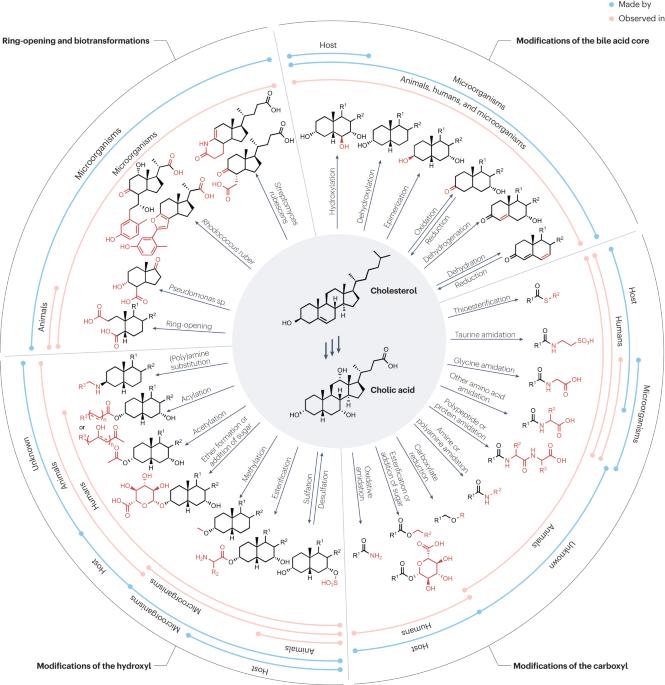The changing metabolic landscape of bile acids – keys to metabolism and immune regulation
IF 45.9
1区 医学
Q1 GASTROENTEROLOGY & HEPATOLOGY
引用次数: 0
Abstract
Bile acids regulate nutrient absorption and mitochondrial function, they establish and maintain gut microbial community composition and mediate inflammation, and they serve as signalling molecules that regulate appetite and energy homeostasis. The observation that there are hundreds of bile acids, especially many amidated bile acids, necessitates a revision of many of the classical descriptions of bile acids and bile acid enzyme functions. For example, bile salt hydrolases also have transferase activity. There are now hundreds of known modifications to bile acids and thousands of bile acid-associated genes, especially when including the microbiome, distributed throughout the human body (for example, there are >2,400 bile salt hydrolases alone). The fact that so much of our genetic and small-molecule repertoire, in both amount and diversity, is dedicated to bile acid function highlights the centrality of bile acids as key regulators of metabolism and immune homeostasis, which is, in large part, communicated via the gut microbiome. Bile acids have important roles in human metabolism and immune regulation. In this Perspective, Dorrestein and colleagues discuss the technologies and data science-related approaches that are improving our understanding of the diversity of bile acids and their multifaceted roles.

不断变化的胆汁酸代谢状况--新陈代谢和免疫调节的关键
胆汁酸可调节营养吸收和线粒体功能,建立和维持肠道微生物群落组成并介导炎症,还可作为信号分子调节食欲和能量平衡。观察到有数百种胆汁酸,尤其是许多酰胺化胆汁酸,有必要对胆汁酸和胆汁酸酶功能的许多经典描述进行修正。例如,胆盐水解酶也具有转移酶活性。现在,已知的胆汁酸修饰有数百种,与胆汁酸相关的基因有数千种,特别是包括微生物组在内,分布在人体各处(例如,仅胆盐水解酶就有 2400 种)。我们的基因和小分子库中有如此多的基因和小分子在数量和多样性上都与胆汁酸的功能有关,这凸显了胆汁酸作为新陈代谢和免疫平衡的关键调节因子的核心地位,而这在很大程度上是通过肠道微生物组传递的。
本文章由计算机程序翻译,如有差异,请以英文原文为准。
求助全文
约1分钟内获得全文
求助全文
来源期刊
CiteScore
52.30
自引率
0.60%
发文量
147
审稿时长
6-12 weeks
期刊介绍:
Nature Reviews Gastroenterology & Hepatology aims to serve as the leading resource for Reviews and commentaries within the scientific and medical communities it caters to. The journal strives to maintain authority, accessibility, and clarity in its published articles, which are complemented by easily understandable figures, tables, and other display items. Dedicated to providing exceptional service to authors, referees, and readers, the editorial team works diligently to maximize the usefulness and impact of each publication.
The journal encompasses a wide range of content types, including Research Highlights, News & Views, Comments, Reviews, Perspectives, and Consensus Statements, all pertinent to gastroenterologists and hepatologists. With its broad scope, Nature Reviews Gastroenterology & Hepatology ensures that its articles reach a diverse audience, aiming for the widest possible dissemination of valuable information.
Nature Reviews Gastroenterology & Hepatology is part of the Nature Reviews portfolio of journals.

 求助内容:
求助内容: 应助结果提醒方式:
应助结果提醒方式:


